Related Research Articles
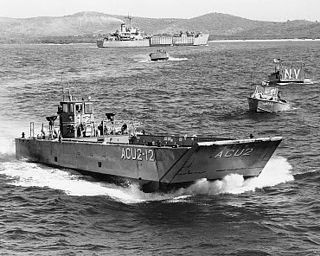
The LCM-8 is a river boat and mechanized landing craft used by the United States Navy and Army during the Vietnam War and subsequent operations. They are currently used by governments and private organizations throughout the world. The acronym stands for "Landing Craft Mechanized, Mark 8".

Royal Navy Dockyards were state-owned harbour facilities where ships of the Royal Navy were built, based, repaired and refitted. Until the mid-19th century the Royal Dockyards were the largest industrial complexes in Britain.

His Majesty's Naval Base, Portsmouth is one of three operating bases in the United Kingdom for the Royal Navy. Portsmouth Naval Base is part of the city of Portsmouth; it is located on the eastern shore of Portsmouth Harbour, north of the Solent and the Isle of Wight. For centuries it was officially known as HM Dockyard, Portsmouth: as a Royal Dockyard, Portsmouth functioned primarily as a state-owned facility for building, repairing and maintaining warships; for a time it was the largest industrial site in the world.
Seafaring is a tradition that encompasses a variety of professions and ranks. Each of these roles carries unique responsibilities that are integral to the successful operation of a seafaring vessel. A ship's crew can generally be divided into four main categories: the deck department, the engineering department, the steward's department, and other. The reasoning behind this is that a ship's bridge, filled with sophisticated navigational equipment, requires skills differing from those used on deck operations – such as berthing, cargo and/or military devices – which in turn requires skills different from those used in a ship's engine room and propulsion, and so on.
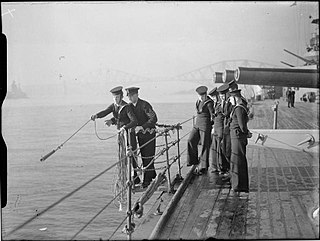
A boy seaman is a boy who serves as seaman or is trained for such service.
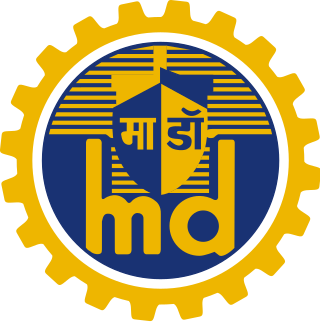
Mazagon Dock Shipbuilders Limited (MDL), formerly called Mazagon Dock Limited, is a shipyard situated in Mazagaon, Mumbai. It manufactures warships and submarines for the Indian Navy and offshore platforms and associated support vessels for offshore oil drilling. It also builds tankers, cargo bulk carriers, passenger ships and ferries.
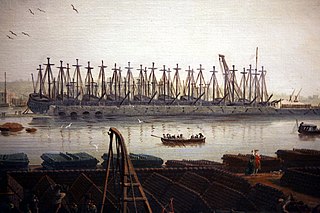
In ordinary is an English phrase with multiple meanings. In relation to the Royal Household and public officials more generally, it indicates that a position is a permanent one. In naval matters, vessels "in ordinary" are those out of service for repair or maintenance, a meaning coming over time to cover a reserve fleet or "mothballed" ships.

The Kingston Royal Naval Dockyard was a Royal Navy Dockyard from 1788 to 1853 in Kingston, Ontario, Canada, at the site of the current Royal Military College of Canada.

HMS Spiteful was a Spiteful-class torpedo boat destroyer built at Jarrow, England, by Palmers Shipbuilding and Iron Company for the Royal Navy and launched in 1899. Specified to be able to steam at 30 knots, she spent her entire career serving in the seas around the British Isles.

Garden Reach Shipbuilders & Engineers Ltd, abbreviated as GRSE, is one of India's leading shipyards, located in Kolkata. It builds and repairs commercial and naval vessels. GRSE also builds export ships.

His Majesty's Naval Base, Devonport is one of three operating bases in the United Kingdom for the Royal Navy and is the sole nuclear repair and refuelling facility for the Royal Navy. The largest naval base in Western Europe, HMNB Devonport is located in Devonport, in the west of the city of Plymouth, England.

The Leander class was a four-ship cruiser programme ordered by the Admiralty in 1880. The class comprised HMS Leander, HMS Phaeton, HMS Amphion, and HMS Arethusa.
The Khulna Shipyard Limited(Bengali: খুলনা শিপইয়ার্ড লিমিটেড) is a Bangladeshi state owned defense contractor based in Khulna, Bangladesh. It is located on 68.97 acres (27.91 ha) of land at Labanchara, Khulna, Bangladesh. It is about 45 km north from the Port of Mongla. The shipyard has the capacity to build steel / aluminium ships up to 90 m length and 700 tons lightweight. The shipyard has a slipway with a capacity to dock and undock vessels up to 700 tons lightweight and overall length of 84 meters.

John H Amos is a paddlewheel tugboat built in Scotland in 1931. The last paddlewheel tug built for private owners, now owned by the Medway Maritime Trust. She is one of only two surviving British-built paddle tugs, the other being Eppleton Hall preserved at the San Francisco Maritime National Historical Park in San Francisco, California.
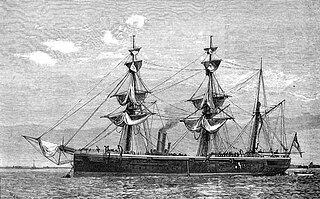
HMS Doterel was a Doterel-class sloop launched by the Royal Navy in 1880. She sank at anchor off Punta Arenas after an explosion on 26 April 1881. Her loss caused the deaths of 143 crew members, and there were 12 survivors. She was en route to join the Pacific Station. Her loss was initially the source of much speculation. Causes considered included an attack by the Fenians, a lost torpedo, and a coal gas explosion. An enquiry in September 1881 concluded coal gas was the cause.
Wave Ruler was a 8,138 GRT Wave-class oiler that was built in 1946 as Empire Evesham by Furness Shipbuilding Co Ltd, Haverton Hill-on-Tees, Co Durham, United Kingdom for the British Ministry of Transport. In 1947, she was transferred to the Admiralty and commissioned into the Royal Fleet Auxiliary (RFA) as Wave Ruler. She was in active service until 1970 when she was hulked in the Maldive Islands, serving RAF Gan until 1975. She was sold in 1976 and scrapped in Taiwan in 1977.
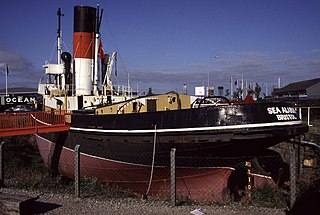
Admiralty tugs were tugboats built for and operated by the Royal Navy. These were vessels built to Admiralty specifications and in specific classes during the First and Second World Wars. They were built to meet the Royal Navy's demand for auxiliary vessels and to supplement the civilian tugs requisitioned by the Admiralty for war service.
HMS Constant was an Archer–class gun-brig of the Royal Navy, launched in 1801 for service against the French during the French Revolutionary and Napoleonic Wars. She was variously stationed in English home waters, the Baltic, the Caribbean, and off the coast of Spain, and was responsible for the capture of at least seven enemy vessels during her fifteen years at sea. The Royal Navy sold Constant at Chatham Dockyard in 1816.
The 1944 King's Birthday Honours, celebrating the official birthday of King George VI, were announced on 2 June 1944 for the United Kingdom and British Empire, New Zealand, and South Africa.
References
- Statement of the Decisions of the Lords Commissioners of the Admiralty on the Petitions received from the Civilian Employees in HM Dockyards and Naval Establishments at Home in 1914
- Admiralty, Conditions of Service, Rates of Pay, Allowances etc. of the Ratings Serving in the Yard Craft at HM Dockyards, Victualling Yards etc. at Home, December 1926
- Admiralty Fleet Order (AFO) 2/62, 5 January 1962